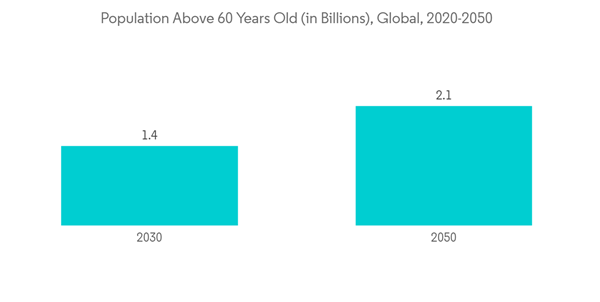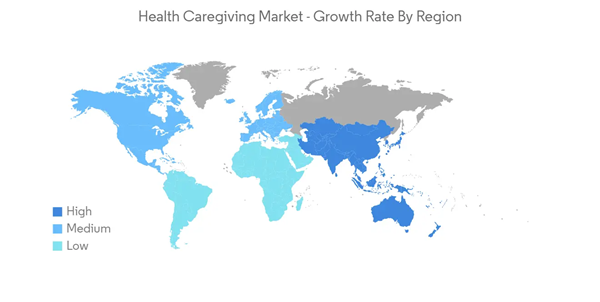The health caregiving market was adversely affected by the pandemic. For instance, in November 2021, a report published by the Blue Cross and Blue Shield Association stated that the elevated rate of COVID-related deaths in long-term care facilities exposed inadequacies in the current system and would refocus attention on in-home care. Due to increased regulatory standards and demand, 30% of long-term care facilities could face bankruptcy in the coming years, forcing even more caregiving impact at home and onto unpaid family and friends. Data on the commercially insured population is supplemented with information on the Medicare fee-for-service population to capture caregiving demand among those 65 and older. The result of this analysis was an estimate that nearly 51 million Americans require some form of caregiving. However, there is wide geographic variation in this population, ranging from 11.1% to 20.7% of the total population at the state level. In addition, the market growth is stabilizing in the current scenario after COVID-19 as the worldwide restrictions have eased and various services have been resumed.
The market for health caregiving is being driven by the increase in disposable income, the prevalence of surgery, and technological developments in the field. For instance, according to the PETERSON-KFF Health System Tracker data published in February 2022, the United States' health care spending increased 9.7% to reach USD 4.1 trillion in 2020, a much faster rate than the 4.3% increase seen compared to the previous year. The acceleration in 2020 was due to a 36.0% increase in federal expenditures for health care that occurred largely in response to the COVID-19 pandemic. The private business share of health spending accounted for 16.7% of total health care spending, state and local governments accounted for 14.3%, and other private revenues accounted for 6.5%.
Moreover, in February 2022, Malta became the first country to introduce iSupport, the WHO online training for caregivers of people with dementia. The training that started in Malta is the result of a two-year effort by the Ministry for Senior Citizens and Active Aging, clinicians, academics, civil society organizations, and caregivers of people with dementia to adapt the original WHO version to the Maltese context.
As a result, all of the aforementioned factors are expected to drive market growth during the forecast period. However, the overall fragmented market weakens the service's adoption potential.
Health Caregiving Market Trends
Geriatric Population Segment is Expected to Hold a Significant Market Share Over the Forecast Period
The geriatric population is prone to diseases and other medical conditions due to low immunity. Hence, the geriatric population requires better care. Hence, the increasing geriatric population is expected to fuel demand for health caregiving facilities and increase market growth. According to the WHO data updated in October 2022, by 2030, one out of every six people will be 60 years of age or older. The number of people aged 60 and up is expected to rise from 1 billion in 2020 to 1.4 billion by 2050. By 2050, the global population of people aged 60 and above will reach 2.1 billion. Between 2020 and 2050, the number of people aged 80 and above is expected to triple, reaching 426 million.According to the same source, while population aging-the shift in a country's population distribution towards older ages-began in high-income countries (for example, 30% of the population in Japan is already over 60 years old), it is now low- and middle-income countries that are experiencing the most change.Two-thirds of the world's population over 60 will live in low- and middle-income countries by 2050. As a result, this will increase the demand for healthcare, thereby boosting market growth. According to a United Nations World Ageing report, in 2020, there were around 12.499 million people aged 65 or over in the United Kingdom. This number is projected to double to 18.775 million in 2050. The population aged 65 or over in the country is expected to increase by 25.3% in 2050. There has been a shift in the leading chronic diseases over the last century, resulting in a significant increase in life expectancy. Noncommunicable diseases, primarily affecting adults and the elderly, pose the greatest threat to global health.
Hence, the growing geriatric population, increasing life expectancy, and associated diseases are projected to boost market growth.
North America is Expected to Dominate the Market Over the Forecast Period
North America is expected to hold a major share of the market during the forecast period. North America has a big share of the global market because of how many people use advanced technology, how common chronic and lifestyle diseases are, how much money is spent on healthcare, how few doctors there are, and how many people want better healthcare services.Factors such as funding, key partnerships, and investments are likely to increase the market's growth in the region. Initiatives by the public sector are one of the key factors for growth. For instance, in July 2021, the state of Indiana expanded its Structured Family Caregiving (SFC) program to allow legal guardians to receive much-needed support to continue caring for older adults in the comfort of their homes. Such initiatives would provide a suitable environment for the market to grow.
According to an estimate from the Canadian Imperial Bank of Commerce (CIBC) for 2021, the cost of caring for aging parents alone in this country is more than USD 33 billion. With an aging population and growing life expectancy, these issues are becoming more integral to the Canadian policy discussion each year. Investments and increased funding are key factors in the growth of the market. For instance, in August 2021, Honor Technology, Inc. acquired Home Instead for more than USD 2.1 billion to become the "default" provider of services for seniors in the United States.
Hence, due to the abovementioned factors, the market is likely to grow in the future.
Health Caregiving Industry Overview
The Health Caregiving Market is partially fragmented and consists of several major players. The competitive landscape includes an analysis of a few international as well as local companies that hold large market shares and are well known. include Vesta Healthcare, Seniorlink, Inc., Lively, Cariloop, and HomeTeam.Additional Benefits:
- The market estimate (ME) sheet in Excel format
- 3 months of analyst support
This product will be delivered within 2 business days.
Table of Contents
Companies Mentioned (Partial List)
A selection of companies mentioned in this report includes, but is not limited to:
- AccentCare
- Amedisys
- Brookdale
- Care.com, Inc.
- Cariloop
- HomeTeam
- Honor Technology, Inc.
- Knight Health Holdings, LLC
- Lively
- Room2Care
- Seniorlink, Inc.
- Vesta Healthcare










